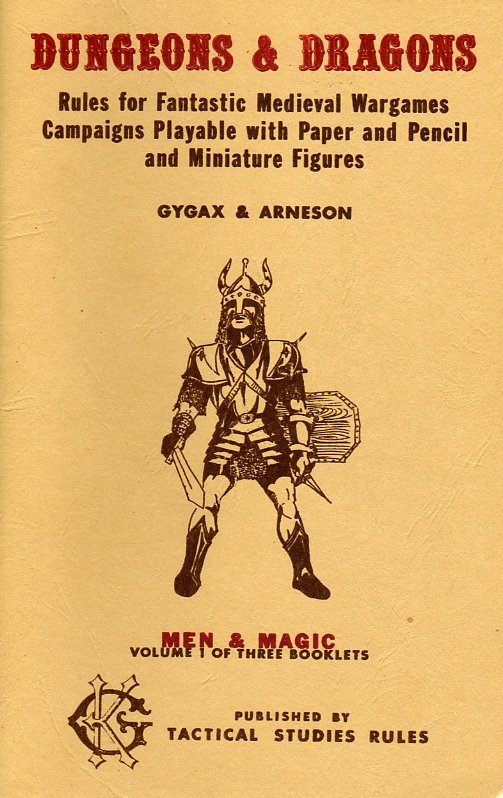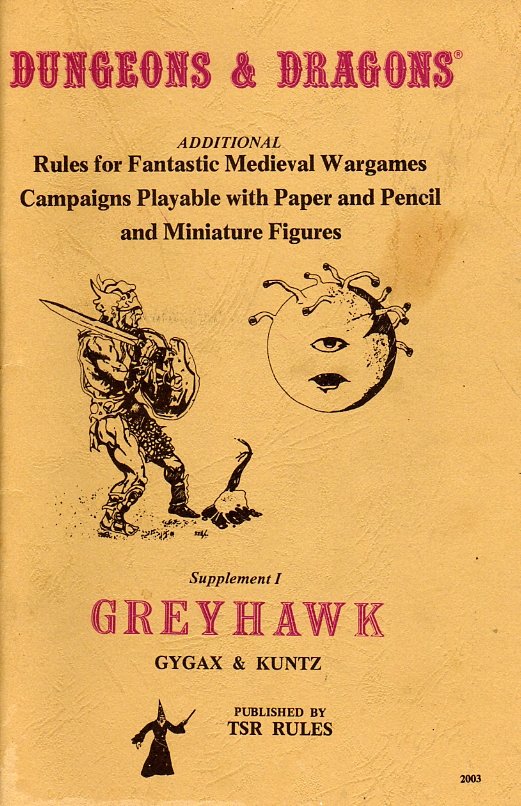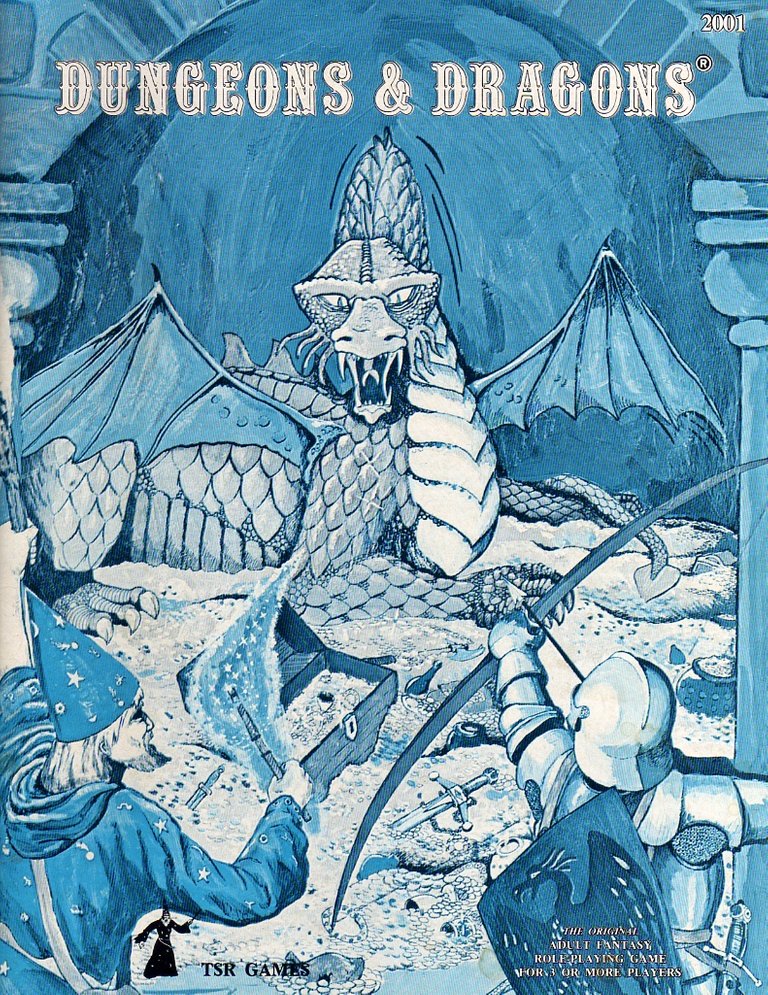(Note: all images in this article are sourced from my own scans.)
Wizards can become invisible and remain so until they attack, they can see in darkness, they affect friendly and enemy morale as do Super Heroes, they throw deadly missiles, and wizards cast terrible spells. [...] A Wizard can throw either of two types of missile (select which before play begins). A fire ball, equal in hit area to the large catapult hit area, or a lightning bolt, 3/4" wide by 6" long, with an attack value equal to a heavy field gun, are the two missile types employed.
-- Excerpted from the rules concerning Wizards on the battlefield, pp. 29-30 of Chainmail rules for medieval miniatures, as authored by Gary Gygax and Jeff Perren, 1971.

1st Level
- Detect Magic
- Hold Portal
- Read Magic
- Read Languages
- Protection/Evil
- Light
- Charm Person
- Sleep
-- Complete list of first level Magic User spells printed in Men & Magic, p. 21 of booklet one of the original Dungeons & Dragons boxed set, as authored by Gary Gygax and Dave Arneson, 1974.
In The Beginning...
...there was no Magic Missile.
Hard to believe, right?
I mean, it's right there in every hardcover going all the way back to 1978. Through nearly five decades' worth of new books, updated editions, and version changes, you can count on finding Magic Missile somewhere in the spell list. It's the Dungeons & Dragons equivalent of Luke deflecting three blaster bolts with his lightsaber on the ride to Alderaan. It's every apprentice mage's first step into a larger world where one day, dice willing, they will gain the power to level mountains and traverse alternate planes of existence on a whim.
Some forms of the spell are different than others to compensate for play balance as required in different rule sets, but the basic idea behind Magic Missile has remained virtually unchanged since its incarnation: it's a 1st-level spell which allows the caster to hurl a magical dart at any target she can see. The dart deals a small but respectable amount of damage, and as the caster increases in level, she gains the ability to throw multiple darts with a single casting. Magic Missile is a staple of 1st-level Arcane casters which remains useful throughout a Mage's career.
And yet, in the beginning, there was no Magic Missile.
Supplement I: Greyhawk
If we want to find Magic Missile's humble beginnings, we need look to 1975, and the publication of the first rules expansion to the Dungeons & Dragons game -- Supplement I: Greyhawk, written by Gary Gygax and Rob Kuntz.

There, on page 20, it shows up along with Shield and Ventriloquism as one of three additional 1st level spells available to mages:
Magic Missile -- This is a conjured missile equivalent to a magic arrow, and it does full damage (2-7 points) to any creature it strikes. For every five levels the magic-user has attained he may add an additional two missiles when employing the spell, so a 6th level magic-user may cast three magic missiles at his target, an 11th level magic-user casts five, and so on.
Straight damage, no saving throw for the target, and a growth in power as the spellcaster levels up. It's all there in one convenient, easy-to-use package.
The foundation has been laid.
Basic Dungeons & Dragons
By 1977, Dungeons & Dragons was clearly not a flash-in-the-pan story. The original three-booklet boxed set had undergone numerous reprints, each one larger than the last, all of which continued to sell out. Likewise, the four supplement books which followed and expanded on the rules of the game received numerous print runs which also sold well. But therein lay the first real "problem" faced by Gary Gygax and his company, Tactical Studies Rules: in the beginning, you paid $12 and got the Dungeons & Dragons game. But as each subsequent supplement arrived, the need to shell out additional cash grew. Greyhawk was 68 pages of new content. Blackmoor, the second supplement, added a further 60 pages, as did its follow-up third supplement, Eldritch Wizardry. By the time the 72-page Gods, Demigods, & Heroes final supplement released in 1976, an avid Dungeons & Dragons enthusiast would have spent more on rules additions than he had on the standard game itself, not to mention more than doubling the original game's page count.
Realizing it would be difficult to bring new players into the hobby if thought they had to buy five separate products (not to mention a bunch of crazy-looking dice) just to start playing, TSR found themselves needing to address a problem of scale which their success had inadvertently created. They found the solution to their problem in John Eric Holmes.
Holmes, a writer and D&D enthusiast himself, approached TSR with an offer to re-write and condense the now-expansive Dungeons & Dragons material into a single, less-expensive book which could be used to introduce new players to the game without forcing them to sacrifice a hefty chunk of their paycheck. The result was the Dungeons & Dragons Basic Set.

Available as either a single 48-page rule booklet, or a boxed set complete with six polyhedral dice, the Basic Set was a highly-condensed and stripped-down version of the first three Dungeons & Dragons booklets along with Supplement I: Greyhawk. As such, the Magic Missile spell appears here virtually unchanged from its original form:
A conjured missile equal to a magic arrow, and it does 1 die roll plus 1 point (2-7) to any creature it strikes. Roll the missile fire like a long bow arrow (Missile Fire Table). Higher level magic-users fire more than one missile.
Holmes didn't bother to explain higher-level spell mechanics in the Basic D&D set, because the rules therein were only meant to take characters to 3rd level. Thus, while the booklet contains a list of 3rd level magic-user spells, including such staples as Fire Ball and Lightning Bolt, it does not describe any of them. As Holmes says in the text:
Third Level Spells can only be used by magic-users of the fifth level and above. They are listed above to give some idea of the range of magical possibilities.
For some reason, cleric spells did not receive the same treatment, and the Basic D&D rules set only printed first- and second-level Clerical magic. Oh well. As long as they had Cure Light Wounds and Bless, everything was fine and dandy among the low-level prelates, I suppose.
Basic D&D capped players at third level, presumably to keep the page count as low, and thus as inexpensive to print, as possible. But what if you wanted to advance beyond 3rd level as a magic-user? You may have also noticed that one of Magic Missile's most notable properties, the fact it will auto-hit with no need to roll dice, is missing -- suppose you want that version of Magic Missile?
Well, for that, you'd need the other project Gary Gygax and TSR had been working on when Holmes approached them about a rules re-write. You'd have to wait until 1978 and the publication of the Player's Handbook.
You'd have to wait for Advanced Dungeons & Dragons.
Along with part two of this article. Ooooh, cliffhangers...!
Drop me your favorite Magic Missile memories down in the comments, if you would be so kind. And until next time, may all your hits be crits.
@tipu curate :)
Upvoted 👌 (Mana: 15/20)
Thank you, @cardboard! :D
but i had to get special dice made that say 2,3,4,5 on them. I hate adding the plus one.
🤣 That is the most gamer-thing I think I've ever heard of, and I applaud your dedication whole-heartedly!
Thank you :)
you know we play a play-by-post Homebrew Fantasy RPG here called HIVEQUEST. You don't have to play but can be good reading. The players comments can be quite good sometimes.
No, I seriously had no idea about this Hivequest! Got a link? I'd love to look through some of the posts and comments! :D
I do all the posting. Just click on me and read through the posts. It started as SteemQuest about 2 years ago.
it is the only thing i post from this account
here is the latest turn
https://peakd.com/hivequest/@simplegame/hive-quest-into-the-ruins-part-1
Here is another turn from back in the day
https://peakd.com/steemquest/@simplegame/steemquest-legs-and-kegs-feast-part-1
Oh, fun!! Can anyone pop in and play, or is there a limited number of participants and everyone else just gets to kibbitz? :)